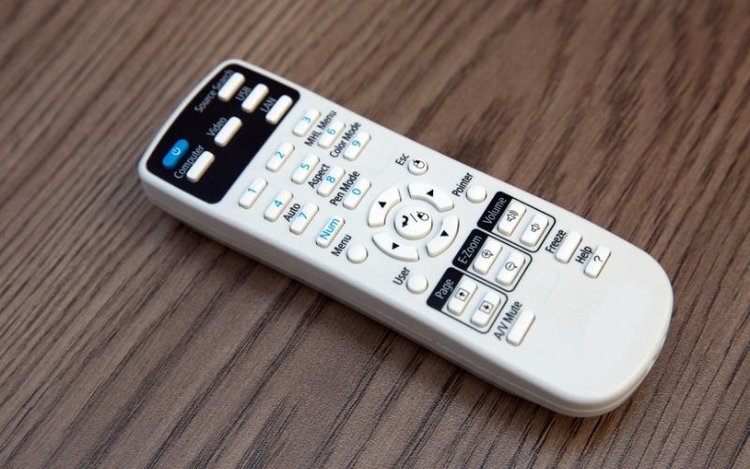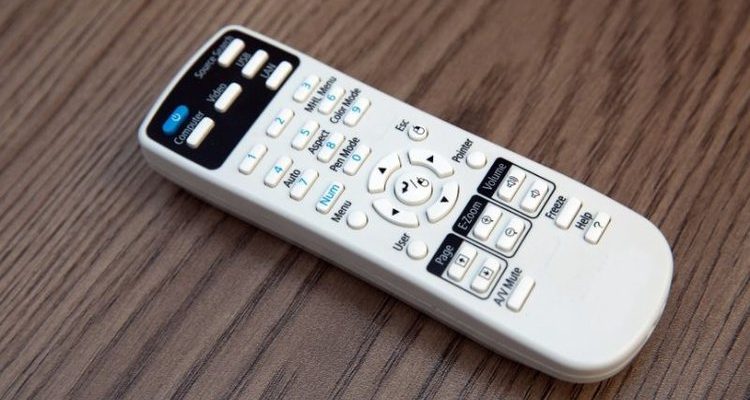
If you’re new to the world of Epson projector remotes, or just hoping to avoid a tech-induced headache, you’re in the right place. I’m going to walk you through each step, like we’re friends puzzling through it together. We’ll talk about the specific types of remotes Epson uses, what batteries you need (because, of course, it’s always dead when you need it), how to pair or sync it with your projector, and even how to troubleshoot if things go sideways. Plus, we’ll talk about universal remote options, just in case that tiny Epson remote vanishes into the couch forever.
Getting to Know Your Epson Projector Remote
Let me explain—Epson makes a variety of projectors, and the remotes are usually tailored to each lineup. Most often, you’ll see a standard Epson remote, looking a lot like a TV remote but with extra projector-focused buttons like “Source Search” or “A/V Mute.” Sometimes, you’ll get a fancier wireless model or even a universal remote if you’ve picked one up separately. But here’s the thing: no matter what type, almost every Epson projector remote shares the same basic DNA. The main differences are in layout, extra features, or some having Bluetooth vs. plain-old infrared (IR) tech.
Before we talk setup, it actually helps to glance over your remote and projector. Notice where the battery compartment lives? Or the little bulb at the top—that’s the IR sender. If you’re using a universal remote, you’ll also want to check the manual for any “Epson code” you need to program. Knowing your remote’s style makes each setup step make a lot more sense and helps you avoid those facepalm moments later.
And hey, if you’ve got a family member who always mixes up the remotes? Maybe stick a neon sticker on the Epson one. Trust me, it’s saved me more than once.
Unboxing and Powering Up: Batteries Matter
I know, batteries aren’t exactly the most thrilling part of this guide, but seriously—they’re step one for a reason. Most Epson projector remotes take standard AAA batteries, hiding snugly under a sliding back panel. Grab two fresh AAA batteries (the good kind, not the half-dead ones scavenged from the junk drawer) and pop them in, matching the little plus and minus symbols. Honestly, it’s wild how often setup woes are just battery mix-ups or weak cells.
Check this before you panic: if your remote feels unresponsive, or the LED light at the top isn’t flickering when you press a button, swap out the batteries again. I’ve had remotes straight out of the box arrive with dead batteries—so don’t assume new always means “charged.”
For wireless or smart remotes, some might use rechargeable lithium batteries. If that’s the case, plug your remote in using the provided USB cable and wait for the charging light to turn green. Patience is key here. It’s better to wait 30 minutes than fight a half-charged remote through setup.
Pairing Your Remote with the Epson Projector
Here’s where things start to feel a bit like a spy movie—syncing up your Epson projector remote so it speaks the same language as your projector. For most setups, it’s as simple as pointing and clicking, but sometimes, especially with Bluetooth-enabled models, you might need a little more finesse.
- For IR (Infrared) Remotes: Simple! IR remotes don’t need formal pairing. Just make sure the remote points directly at your projector, with no large obstacles in the way. If you’re sitting at a weird angle, try moving so you have a clear line of sight.
- For Bluetooth Remotes: These might require a quick sync—the process usually involves going into the projector’s settings (using the side buttons, if needed), selecting “Bluetooth Setup,” and following on-screen prompts to pair. Hold down the Pair or Sync button on the remote until the projector detects it.
- For Universal Remotes: Here’s where those famous “remote codes” come in. Each universal remote will ask you to enter an Epson projector code (found in the manual or online), then test the buttons to confirm they work. If nothing happens, don’t stress—sometimes it takes a couple tries or a different code.
If your Epson remote refuses to cooperate, try powering both projector and remote off and on again. It sounds silly, but trust me, half the magic of electronics is the classic reset.
Using Your Epson Projector Remote: The Essentials
Once you’re up and running, life with your Epson projector remote gets a lot smoother. The layout is designed to be intuitive, but if you’ve ever squinted at a sea of tiny buttons, you know it can be a bit overwhelming.
Let me walk you through a typical Epson remote:
- Power Button: Does exactly what you’d expect—turns the projector on or off.
- Source/Search: Lets you switch between HDMI, VGA, USB, or whatever device you’ve got plugged in. Super handy if you’re juggling a laptop, console, or streaming stick.
- Menu and Arrow Keys: This navigates the projector’s settings for color, brightness, aspect ratio, or even the network setup.
- Volume Controls: Not all projectors have internal speakers, but if yours does, you can pump up the sound from the remote.
- A/V Mute: Instantly blanks the screen—great for pausing a presentation or hiding spoilers while you grab snacks.
Think of the remote as your magic wand—just don’t let it disappear between the cushions.
You might be wondering, “What if I lose my menu navigation in the endless settings?” Don’t stress. The “Menu” button is your home base; tap it any time you want to start over. It’s basically your digital ‘undo’ button.
Troubleshooting Common Remote Problems
Remote setup isn’t always a fairy tale, so let’s chat about what happens when things don’t go according to plan. If your Epson projector remote isn’t working, don’t panic—here are some classic fixes.
- Check the Batteries: Seriously, double-check! Low battery is the number one culprit.
- Reset the Remote or Projector: Some Epson remotes have a reset button (a tiny pinhole—use a paperclip). Hold it for a few seconds. For the projector, unplug it for 10 seconds, then plug it back in.
- Clear Line of Sight: IR remotes need a clear path—no books, decor, or overzealous pets blocking the way.
- Try a Universal Remote: If the original remote is toast, universal remotes are a lifesaver. Just make sure to input the right code. Sometimes, it’s a matter of trial and error—don’t give up after the first code.
If you’re still stuck, Epson’s support site is actually pretty friendly, or you can find plenty of helpful setup videos online. (I’ve been that person frantically Googling at 2 AM—no shame.)
Universal vs. Epson Branded Remotes: Things to Know
Here’s a little detour—what if your Epson remote is lost to the void? Maybe it fell behind the TV or got eaten by the dog (hey, it happens). In that case, universal remotes are a solid Plan B. But, there’s a few trade-offs worth knowing.
Epson’s official remotes are tuned perfectly for their projectors—every button lines up with a feature. Universal remotes, on the other hand, are the Swiss Army knives of the remote world. They work with dozens of brands, but the button layout might not match, and sometimes features are missing. You’ll have to input the right code, and some functions like picture-in-picture or advanced color settings might not work.
If you like everything seamless and matching? I’d go with Epson’s official remote. But if you want to control your projector, TV, and game console with one click—even if it means losing an advanced feature or two—a universal remote can be a game changer.
How to Reset Your Epson Projector Remote
Sometimes, nothing works quite like a reset—think of it as giving your remote a fresh start and a little pep talk. If your remote just won’t sync, responds weirdly, or is acting haunted (you know, random button presses lighting up), a reset can clear up software glitches, code issues, or memory overloads.
- Standard Epson Remote: Look for a tiny pinhole labeled “Reset” on the back or inside the battery compartment. Use a thin object like a paperclip, press and hold for five seconds, and release. Your remote should flash or blink, indicating it’s ready to pair again.
- Bluetooth Remotes: Sometimes, resetting means holding down both the Pair/Sync and Power buttons together for 10 seconds. Check your model’s manual for the exact combo.
- Universal Remote: Usually, there’s a “master reset” sequence—like holding Mute + Select for a few seconds. The manual or label inside the battery compartment should tell you more.
After resetting, you’ll probably need to re-pair or enter your Epson code again. It’s a little extra work, but often it’s the quickest way to solve head-scratching remote problems.
Tips for Long-Term Remote Care
Imagine this: you’ve got the remote working perfectly, but a couple months down the road, trouble returns. Here’s how to keep your Epson projector remote happy and healthy for the long haul.
- Avoid Battery Leaks: Take the batteries out if you won’t use the projector for a while (like over summer holiday). Trust me, nothing ruins a remote like battery goo.
- Keep It Clean: Dust and grime love to hide in button crevices. A quick wipe with a microfiber cloth keeps everything fresh.
- Store It Safely: Set up a “remote spot”—a bowl, a tray, or magnetically on the side of your projector. It sounds goofy, but less time searching means more time enjoying movies.
- Label It: If you’ve got more than one remote at home, a simple label can save you a world of confusion.
If you ever need to replace your Epson projector remote, you’ll find official versions online or at electronics shops. Just double check the model number—using the wrong remote is like showing up to a costume party in the wrong theme: confusing for everyone.
Your Epson Projector Remote, Sorted
So, there you have it. Setting up an Epson projector remote might seem intimidating at first, but it’s really about a few small, logical steps—pop in the right batteries, pair or sync if needed, double check that nothing’s in the way, and you’re golden. If your remote ever gives you trouble, now you’ve got a whole toolbox of troubleshooting tricks to fall back on.
Honestly, the hardest part is keeping the remote from disappearing between couch cushions (but if you figure out a system for that, let me know). For now, you’re ready to control the action—whether it’s a business presentation, movie night, or epic gaming session. Happy projecting!
